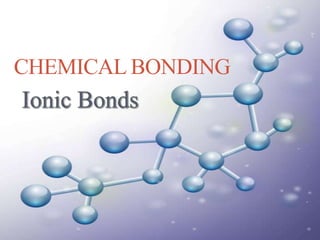Ionic Bonds.pptx
•Download as PPTX, PDF•
0 likes•4 views
Chemical bonds form when positively charged atomic nuclei attract negatively charged electrons. Compounds are formed when two or more different atoms combine through chemical bonds, such as carbon dioxide (CO2) and water (H2O). Valence electrons are in the outermost shell and atoms seek stable arrangements of 8 electrons through bonding. Ionic bonding occurs through the transfer of electrons between metals and non-metals to form positively charged ions and negatively charged ions that are attracted to each other.
Report
Share
Report
Share

Recommended
More Related Content
Similar to Ionic Bonds.pptx
Similar to Ionic Bonds.pptx (20)
More from ErwinMapalad
More from ErwinMapalad (6)
Recently uploaded
This slide is prepared for master's students (MIFB & MIBS) UUM. May it be useful to all.Chapter 3 - Islamic Banking Products and Services.pptx

Chapter 3 - Islamic Banking Products and Services.pptxMohd Adib Abd Muin, Senior Lecturer at Universiti Utara Malaysia
Recently uploaded (20)
Matatag-Curriculum and the 21st Century Skills Presentation.pptx

Matatag-Curriculum and the 21st Century Skills Presentation.pptx
The Art Pastor's Guide to Sabbath | Steve Thomason

The Art Pastor's Guide to Sabbath | Steve Thomason
Welcome to TechSoup New Member Orientation and Q&A (May 2024).pdf

Welcome to TechSoup New Member Orientation and Q&A (May 2024).pdf
Salient features of Environment protection Act 1986.pptx

Salient features of Environment protection Act 1986.pptx
Instructions for Submissions thorugh G- Classroom.pptx

Instructions for Submissions thorugh G- Classroom.pptx
Jose-Rizal-and-Philippine-Nationalism-National-Symbol-2.pptx

Jose-Rizal-and-Philippine-Nationalism-National-Symbol-2.pptx
aaaaaaaaaaaaaaaaaaaaaaaaaaaaaaaaaaaaaaaaaaaaaaaaaaaaaaa

aaaaaaaaaaaaaaaaaaaaaaaaaaaaaaaaaaaaaaaaaaaaaaaaaaaaaaa
Overview on Edible Vaccine: Pros & Cons with Mechanism

Overview on Edible Vaccine: Pros & Cons with Mechanism
Basic Civil Engineering Notes of Chapter-6, Topic- Ecosystem, Biodiversity G...

Basic Civil Engineering Notes of Chapter-6, Topic- Ecosystem, Biodiversity G...
UNIT – IV_PCI Complaints: Complaints and evaluation of complaints, Handling o...

UNIT – IV_PCI Complaints: Complaints and evaluation of complaints, Handling o...
Chapter 3 - Islamic Banking Products and Services.pptx

Chapter 3 - Islamic Banking Products and Services.pptx
Ionic Bonds.pptx
- 2. Chemical Bonding - chemical bond is what holds atom together in molecules. Bonds arise from the electrostatic forces between positively charged atomic nuclei and negatively charged electrons.
- 3. Compounds - are formed when two or more atoms of different elements combined Example: 𝐶𝑂2 𝐻2𝑂 𝑁𝑎𝐶𝑙
- 4. Valence Electrons - are electrons in the outermost energy level. - tends to react to have a stable arrangement of 8 electrons in the outermost shell; Octet Rule
- 5. Group 1 2 13 14 15 16 17 18 Valence Electrons 1 2 3 4 5 6 7 8 Diagram Li Be B C N O F Ne
- 6. Electron Dot Structures - a.k.a Lewis structure, type of diagram used to keep track of the valence electrons.
- 7. Quick Check Using the Periodic table, complete the table below. Element Group No. Valence Electrons Electron Dot Structure Magnesium Potassium Phosphorus Sulfur Argon
- 8. Ionic Bonding - it involves transferring of electrons. - occurs when there is an attraction between negatively charged ions and positively charged ions. - occurs between metals and non metals.
- 10. Metals (Cations) Non-metals (Anions) Li Mg Al N O F Na Ca Ga P S Cl K Sr Se Br 1.0 1.3 1.6 3.0 3.5 4.0 0.9 1.0 1.8 2.1 2.5 3.1 0.8 1.0 2.5 2.9
- 11. Ionic Charges
- 12. Metals (Cations) Non-metals (Anions) Li Mg Al N O F Na Ca Ga P S Cl K Sr Se Br +1 +2 +3 -3 -2 -1
- 13. Exercise Write the Chemical Formula and Chemical Name of the following. 1. Potassium and Flourine (Illustrative) 2. Calcium and Bromine (Simplest Way)